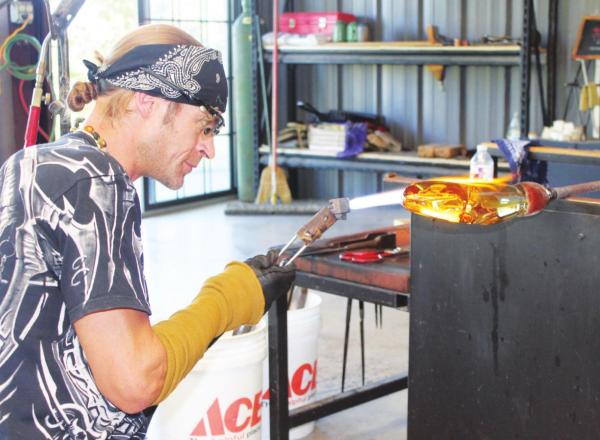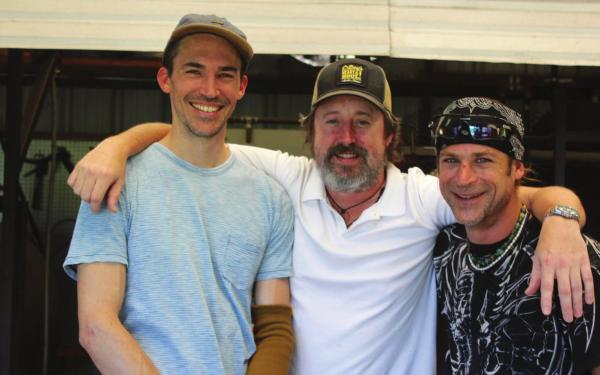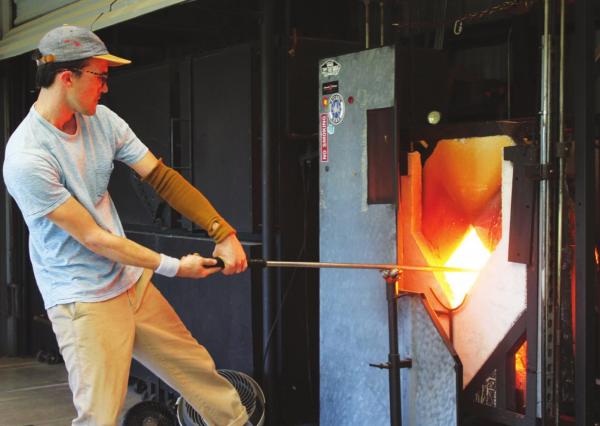Creating art with Lawson Glass
Jason Lawson thought the antlers on mule deers were beautiful. He loved the grace, the symmetry, the balance.
Jason, a glass artist, decided the antlers would translate perfectly into a luxury lighting fixture.
As he worked on the design, the first 25 antlers he produced resembled crow’s feet. The next 50 looked more like branches from a tree. Finally, his design started to take shape. Mule deer antlers were recreated with glass. “It was pretty painful,” Jason recalls.
That was in 2011. Since then, the chandeliers have been installed all over the world — London, Dubai and Cape Town, South Africa. The chandeliers are definitely high end with prices that range from $8,000 to $60,000.
The fixtures are painstakingly crafted by LWSN (pronounced Lawson) Glass at his studio in Fischer. The typical chandelier has eight antlers and weighs about 100 pounds. There’s a small LED light installed in the bottom that sends light flowing through the antlers. The antlers are mounted in a bronze base molded by Driftwood sculptor Michael Hall.
“I was sick and tired of doing everyone else’s ideas,” says Jason. “I just wanted to make something that people would see and want to own. I started making glass for the one percent.”
Love at first sight
Jason was born in Dallas and while pursing a degree in graphic design at Texas Tech in Lubbock he stumbled upon a glass-blowing class. The attraction was immediate.
He remembers as a child being fascinated by his grandmother’s goose shaped, blown-glass napkin holder, but beyond that glass making was a complete unknown.
“When I got into glass I had no prior knowledge of the craft,” he explains. “I had never even seen hot glass. But the immediacy of the material appealed to me. It was clean and beautiful.”
He spotted an ad for an apprentice job at Wimberley Glassworks and remembers the stunning Hill Country landscape in the background. He was quickly hired by Tim De Jong, the owner of the Glassworks.
It was there he was introduced to the Italian-style of glass making, a type of glass that’s “fast, fluid, clean and thin.”
He worked at Wimberley Glassworks for four years before deciding to go out on his own.
History of glass
Glass has been around for a long time.
People in the Stone Age used naturally occurring glass — commonly obsidian — for knives, arrowheads and jewelry. The first man-made glass dates back to around 3500 BC in the Middle East. Glass beads found in the region of modern-day Iraq, Kuwait, Egypt, and Syria have been traced to 2500 BC.
By 1100, Venice had become the glass manufacturing center of the western world. During the 1400s, a Venetian glass blower named Angelo Barovier created a transparent glass that was almost colorless.
Soon, the Venetian style of glass making spread north. In the late 1600s, leaded glass was manufactured in England.
The first glass-making facility in the United States was built in Jamestown, Virginia in 1608.
The demand for glass grew and hand-blown bottles and glasses were replaced by machine-made glass that could be reproduced quickly and precisely. In 1904, an American engineer came up with the idea for an automatic bottle-blowing machine.
According to the website History of Glass, glass is about three-quarters silica, basically quartz. Pure silica has a melting point of around 3,600 degrees.
Over the years, glass makers have used additives to help lower the melting point and strengthen the glass.
His own studio
Jason bought two acres in Fischer and, in 2008, started work on his own studio.
He would sell his unique antler chandeliers at trade shows. “The shows were hard,” he says, “but they got me nationally represented and I learned how to work with clients and do custom jobs.”
He decided to concentrate of the luxury lighting market. He rarely does shows these days, instead relying on word of mouth and the Internet. “Business is good. We have had investors jumping in,” Jason says.
Jason no longer works in the factory. Glass makers Brian Roughton and Michael Field now run the factory with its blazing orange furnaces. The two have an almost-choreographed routine as they shape the balls of molten glass into the graceful antlers.
Carrie Head, Jason’s “partner in life and partner in business,” handles the marketing end of LWSN Glass. “She is definitely a big part of our success,” says Jason.
Branching out
Jason now produces two lines of chandeliers. The more expensive is the “fine art” line and his lower priced, the “industrial” line.
“We had a lot of people calling and when we told them the price they would have a heart attack. So we came up with some lower priced options.”
The “fine art” fixtures feature bronze bases made by Hill Country sculptor Michael Hall. The “industrial” design bases are the work of widely-known San Antonio metal fabricator Ted Voss.
Writes Jason in his promotional material: “It’s been very rewarding to work with so many great artists…it could not have been done without them. All of us are so fortunate to live in a place where such talent exists and is cultivated.”
Mostly LWSN produces antlers but there is also the Diamond style that, he says uses, “age old techniques with new age technology.” The Diamond glass has a pebbled surface, as opposed to the sleek, smooth glass of the antlers.
For more information about the glass go to www. lawsonglass.com or call 512-623-9043.




